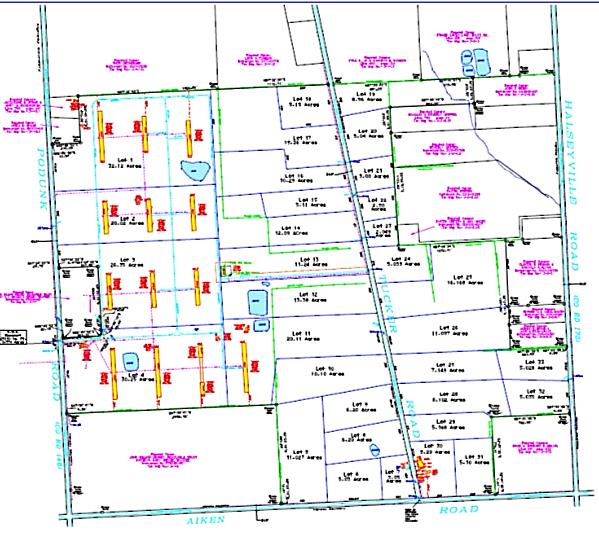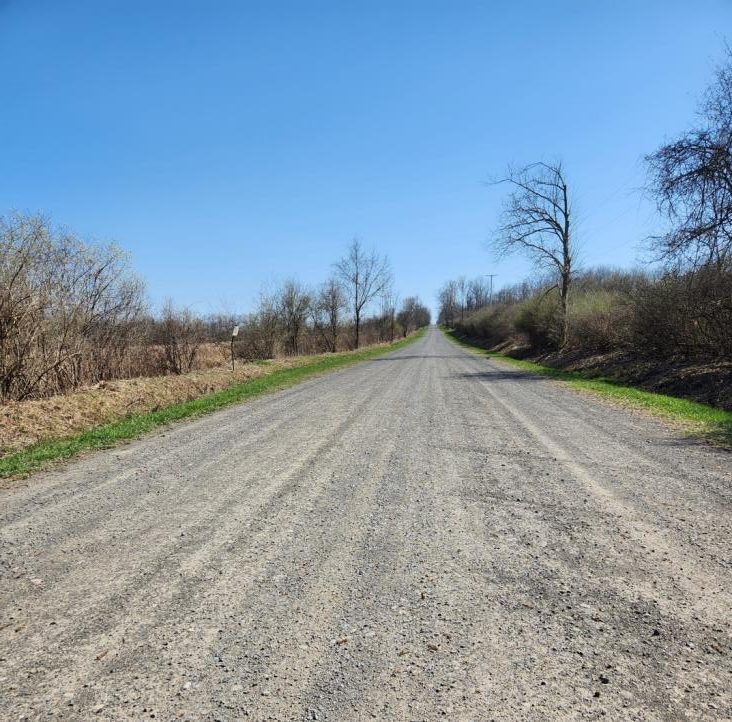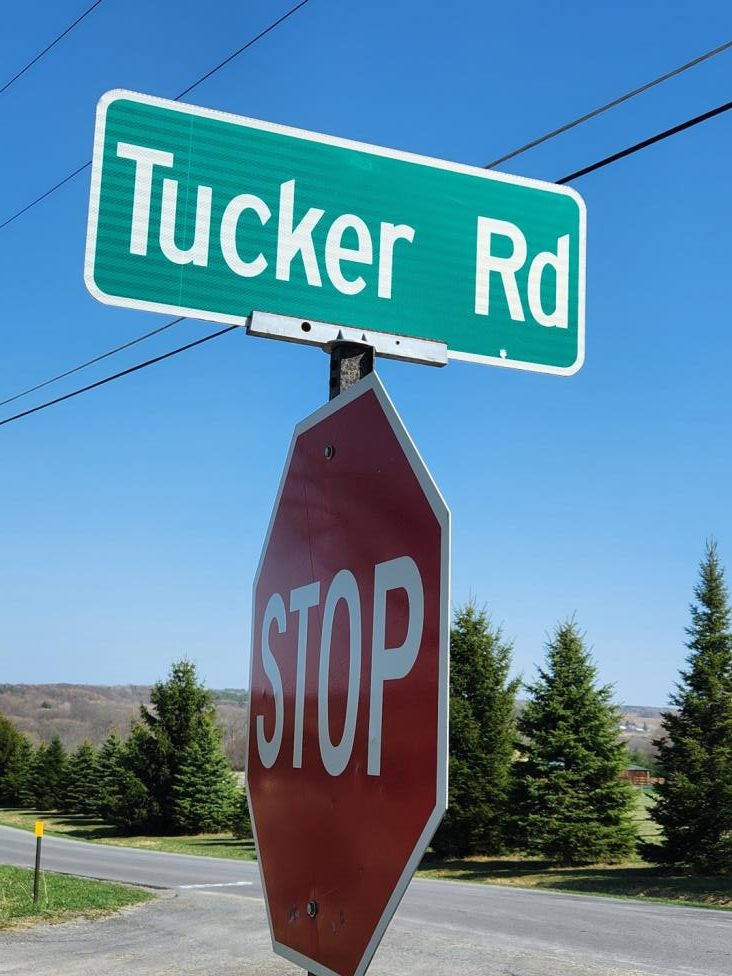
Breezy Meadows’ Impacts Perplex Planners, Pols, and Public
Analysis by Robert Lynch, April 20, 2023
“There’s no question that there’s a lot of people that have water problems in the Town of Enfield.”
Planning Board Chair Dan Walker to the Town Board, April 12.
“I’m not sure there’s much we can do.”
Enfield Councilperson Jude Lemke (same meeting)
****
Planning Board reports to the Enfield Town Board are usually cut-and-dried affairs; over in a flash. But April’s encounter proved much different. This time, Planning Board Chair Dan Walker took a full ten minutes short of an hour to answer—and to at times, agonize—over Town Board members’ questions concerning the controversial “Breezy Meadows Farm” subdivision. All the time, Breezy Meadows’ project manager Alan Lord sat (presumably) behind a zoom tile that bore his name. He never spoke a word.
“This is the biggest controversy that’s hit Enfield since the Black Oak Wind Farm,” this writer, Councilperson Robert Lynch, observed during his own turn to comment at a Planning Board-sponsored Public Hearing one week before the Town Board’s own April 12th Breezy Meadows discussion. “And I’ll tell ‘ya: We don’t have zoning, and we don’t need zoning to deal with this problem.” I had other plans. But whether those plans will work, we have yet to learn.

Breezy Meadows, New York Land & Lakes Development’s plan to subdivide the former John William Kenney farm between Podunk and Halseyville Roads into 33 building lots of varying sizes, has faced criticism ever since someone stuffed copies of its site plans in neighborhood mail boxes in early-December. Town Planning Board review of the 337-acre subdivision led to the April 5th hearing. After about eight people spoke, and as many as a score looked on to see what transpired, Planning Board members weighed the project’s merits versus its risks. They made no decisions that night. But Board Chair Walker signaled he might move adoption of a required Environmental Assessment at the early-May Board meeting, with subdivision approval to follow.
Nonetheless, one week later, after struggling to answer Town Board concerns about the subdivision’s impact, Walker backed off a bit.
“Right now, I don’t see a final approval coming at the May meeting,” Walker told the Town Board April 12th, “because we don’t have all the data in yet.”
Yet Walker made no promises. “The Planning Board is an independent Board. And we do follow the regulations of the State and our Town’s Site Plan and Subdivision regulations,” the Chairman reminded anyone who would listen. “We are an independent Board, as we do our due diligence. I think we are very careful about doing that.”
Exacting timetables aside, odds right now point in Breezy Meadows’ favor. While public opinion tumbles decidedly against the project, and while some Town Board members voice concerns, the key decision-makers in Enfield’s most contentious housing controversy either lean in the project’s favor, or simply accept its inevitability.
“I’m not sure there’s much we can do,” Councilperson Jude Lemke warned after Councilperson Lynch cautioned that a 33-lot rural subdivision could easily double or triple in density if lot purchasers ignore Land & Lakes’ intended deed restrictions and simply subdivide their parcels further.
“The subdivision meets all of the Town’s regulations under the Subdivision Regulations,” Walker advised the Town Board. “So we really have no basis for denying the subdivision.”
“Unfortunately, if they start to (further) subdivide all these properties, then we’re going to have to deal with the issue then, because today there’s nothing in our law that would prevent them from doing this project,” Lemke advised.
Transforming open fields into hobby farms, mini-estates, or equestrian pastures may jar the senses of those who remember what the old Kenney farm used to be. Short of a total ban on development, the town can do little to hold back some degree of progress. But to Breezy Meadows’ critics, concerns lie far deeper—in some respects, literally deeper. Foremost among the concerns of many is the impact 33 (or more) new homes would have on a water supply that just about everyone agrees remains marginal at best.
“We’ve always had problems with the amount of water for the household. To overlook that would be a problem,” Iradell Road resident Russ Carpenter told the planners’ Public Hearing. “I really think… if you’re going to have this much housing development, you really have to consider the Town’s putting in a water district of some sort,” Carpenter said, suggesting that public sewers may need to follow.
“We’re not going to have public water in my lifetime; probably (in) most of your lifetimes. We have to rely on wells,” Lynch answered. “Our neighbors cannot run out of water.”
At both the Planning Board’s hearing, and a week later before the Town Board, Lynch pushed for Land & Lakes Development to do the same thing that the ill-fated Black Oak Wind Farm’s developers had to do a decade ago, namely perform a full-blown Environmental Impact Statement (EIS), not just the much more abbreviated “Environmental Assessment” Land & Lakes has already undertaken, aided by Walker’s assistance. Lynch would have Breezy Meadow’s developers focus on water issues; both the project’s impact on neighboring wells and also on water quality. “A full hydrological study,” I told the hearing, is what’s needed.
How much might such a study cost, Lemke asked Walker at the Town Board’s meeting. Walker guesstimated between $20,000 and $50,000 based on the developer’s need to drill a series of test wells at perhaps 4-5 thousand dollars per drill.
This Councilperson shot back, “It’s costing $20-50 thousand. The developer’s paying $1.6 Million for the land. It’s a drop in the bucket!”
But Dan Walker has repeatedly expressed doubt that water will be an issue, the chairman relying on the assumption that the Breezy Meadows’ lots, that would range in size from two to 32 acres, would be spread out sufficiently so that one owner’s well would not drain dry another, or far more importantly, anyone else’s well lying outside the development. Indeed, speaking before the Town Board, the Planning Board’s Chair suggested that a more tightly-packed four-lot subdivision already built at Van Dorn and Enfield Center Roads impacts its own water table much more.

“At this point, I have no documentation that this is going to be a major issue,” Walker told the Town Board concerning water supplies and pushing back on the need for an EIS. “Based on my experience with shale aquifers, (it’s that) they are low producing aquifers, but they generally stay pretty consistent unless you have huge demand on them.”
“The size of the lots provides enough area to protect other wells,” Walker reasoned. And if the dangers of well depletion were greater, Walker told the Town Board, “We’d have to do an EIS and a hydrological study for every two-lot subdivision” that the Codes Inspector, Alan Teeter, approved.
Walker readily admitted during Town Board questioning that Breezy Meadows’ siting puts it in a place where, as Russ Carpenter testified, well water conditions leave much to be desired.
“There’s no question that water supply in the Town is variable,” Walker said. “But with the low density of this development, the average of 10-15-acre lots, there’s enough separation that it shouldn’t be impacting adjoining neighbors.”
A state-prepared well survey—one that only lists newer wells drilled since about 2000, and relied on by the Board Chair to support his assessment—lists most wells near the proposed development in the 150-200 foot depth range, often producing water at an average two gallons per minute.
“They’re not the best producing wells,” Walker acknowledged. What’s more, he admitted, “a two gallon/minute yield can be run out if you aren’t careful with your water uses.”
A new home is going up just off the Breezy Meadows site, on Aiken Road near Halseyville. A well’s being drilled there. And Walker told the Town Board he’ll look closely at that new well’s performance once drilling is complete.
****
Paul Tunison knows the condition of Tucker Road. He and his wife live there. “The condition of Tucker Road is pretty bad,” Tunison told the April 5th hearing. Without a doubt, Tucker Road’s condition—now and in the future—bears heavily on Breezy Meadows’ impact. Gravel-based Tucker effectively bisects the development site, and Land & Lakes would front as many as 24 of its 33 building lots on it.

“It’s essentially a one-and-a-half lane road. It’s passable. But it can’t handle the kind of traffic for the 23-24 residences that are proposed for this subdivision,” Tunison told the hearing. Who’s going to pay for its upgrade, he asked. Tunison thinks the developer should pay.
Hayts Road sheep farmer Marguerite Wells agrees. And she brought figures—however accurate they may be — to the Planning Board’s hearing. By Wells’ calculations, at current estimates of $200,000 per mile, the paving of Tucker Road would eat up a full 19 per cent of the Enfield Highway Department’s budget in a single year. And it would take 10-15 years for the increased assessments of the newly-fronted residences on Tucker to pay back the cost.
Dan Walker and Enfield Highway Superintendent Barry “Buddy” Rollins take a different view. They sense no urgency for Tucker Road’s paving. Walker had talked with Rollins prior to the Planning Board’s review, and Rollins, himself, addressed the road’s condition at the Town Board’s meeting.
“(Rollins) feels Tucker Road is in pretty good condition for an unimproved gravel road,” Walker informed the Planning Board. The Superintendent “did not feel there was a need to totally rebuild the road,” Walker reported. “We have other gravel roads in the town that are in worse shape.”
Rollins told the Town Board a week later that he’s worked on Tucker Road. He reported that the ditches are good, and there are “very few potholes or wet spots.” Rollins continued, “My goal is to make all roads oil and stone roads.” And that, he said, includes Tucker. With oil and stone, the Superintendent stated, “That will handle car traffic and most delivery traffic, but not tractor-trailers and 10-wheelers every day.”
Of course, those bigger trucks could infect Tucker Road during Breezy Meadows’ construction.
“Our approval will state that this is a gravel road, and the Town has no plans to upgrade that to a paved road,” Walker told the Town Board, regarding Tucker. “The expectation should not be that that’s going to be a paved road.”
Councilperson Lynch, this writer, pushed back:
“The question is: ‘The road is never going to be improved; it’s going to remain a gravel road’ is all right until you get 24 people with houses along Tucker Road, and they come to this Town Board and say please pave that road. That’s going to happen if it gets a lot of use regardless of what the land seller tells the homeowner. They’re going to say ‘we want a better road.’”
The final spindle bracing this awkward, three-legged stool of opposition involves farmland. Land & Lakes estimates that the Kenney farm has 145 acres of agricultural land and that subdividing it would only take 29 acres away. Critics (including this writer) maintain farmable acreage would shrink to near zero. Soil quality remains subject to debate. Sheep farmer Wells chooses to think positive.
“There’s a very strong demand locally for farmland,” Wells told the Public Hearing. “There are so many farmers who would love to rent that farm.”
“We are all beneficiaries of this beautiful rural quality of life,” Wells continued. “But they could do a much more careful job of subdividing these parcels to protect the farm parcels and allow farming to continue.”
Wells presented the Planning Board a Crayola sketch of her redesign that would cluster houses on one portion of the Kenney farm and leave the rest to agriculture. Walker later critiqued Wells’ alternative.
To “densify” the property, “could actually create more water supply problems,” Walker told the Town Board.
But Wells remains undeterred. “Leave the farmland as farmland, and leave the dirt road (Tucker) as not a burden to the taxpayers of Enfield,” she pleaded.
Not all agree that Breezy Meadows’ soils are so prime or that its acreage will attract a line of bidders.
“It is not now being farmed because the farmer that was farming a lot of that land said he had problems getting a crop up every year because of the wetness conditions, and that the lease cost of the farmland was not worth it to him,” Walker informed the Town Board, the planner relying on what the developers had told him.
The Board Chair also posited that nothing would preclude a farmer from purchasing several of Breezy Meadows adjoining lots and merging them into a farmable field. Still, without a doubt, Land & Lakes’ would charge that farmer inflated prices more applicable to people than cows.
****
Where the Breezy Meadows’ debate leaves all of Enfield right now is with guarded uncertainty; and also with an unsettling expectation that this 33-lot subdivision will happen one way or another. Even were Enfield to be zoned, a large-lot slicing and dicing of an overpriced abandoned farm is hard to stop.

At the April 12th meeting’s start, this Councilperson advised he might introduce a Town Board motion regarding Breezy Meadows. “Does the Board believe we should provide the Planning Board some guidance on this, or should we just keep our powder dry right now?” Lynch asked later after the Town’s Board and top planner had gone back-and-forth. (A Resolution lay at the ready.)
“I’d like to hold off and see what data Dan puts forward at the next meeting,” Supervisor Stephanie Redmond responded. Thus, for the moment, the Town Board’s powder remains dry.
Breezy Meadows is an Enfield controversy not soon to fade away. And it won’t fade away after the Planning Board’s next meeting… or the meeting after that. But the May third session could prove pivotal. We’ll all see what happens then.
###

